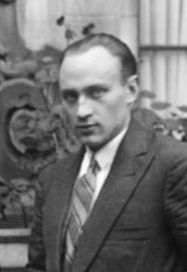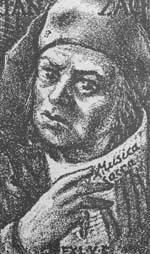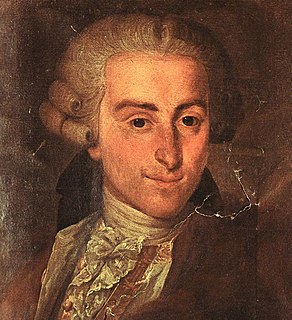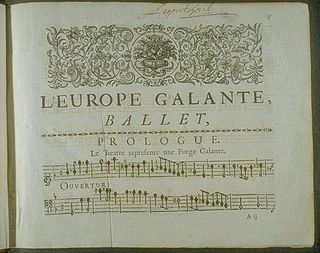Related Research Articles

The Classical period was an era of classical music between roughly 1730 and 1820.

Wolfgang Amadeus Mozart, baptised as Joannes Chrysostomus Wolfgangus Theophilus Mozart, was a prolific and influential composer of the Classical period. Despite his short life, his rapid pace of composition resulted in more than 800 works of virtually every genre of his time. Many of these compositions are acknowledged as pinnacles of the symphonic, concertante, chamber, operatic, and choral repertoire. Mozart is among the greatest composers in the history of Western music, with music admired for its "melodic beauty, its formal elegance and its richness of harmony and texture".
A concerto is, from the late Baroque era, mostly understood as an instrumental composition, written for one or more soloists accompanied by an orchestra or other ensemble. The typical three-movement structure, a slow movement preceded and followed by fast movements, became a standard from the early 18th century.
Rondo is an instrumental musical form introduced in the Classical period.

Paul Sacher was a Swiss conductor, patron and impresario. He founded and conducted the Basler Kammerorchester (1926–1987). He commissioned notable works of composers of the 20th century and premiered them with the chamber orchestra. While better known for his interest in new music, he was also devoted to music of baroque and classical eras; he founded the Schola Cantorum Basiliensis, institute for early music, in 1933.

Jan Zach, called in German Johann Zach was a Czech composer, violinist and organist. Although he was a gifted and versatile composer capable of writing both in Baroque and Classical idioms, his eccentric personality led to numerous conflicts and lack of steady employment from about 1756 onwards.
The siciliana[sitʃiˈljaːna] or siciliano[sitʃiˈljaːno] is a musical style or genre often included as a movement within larger pieces of music starting in the Baroque period. It is in a slow 6
8 or 12
8 time with lilting rhythms, making it somewhat resemble a slow jig or tarantella, and is usually in a minor key. It was used for arias in Baroque operas, and often appears as a movement in instrumental works. Loosely associated with Sicily, the siciliana evokes a pastoral mood, and is often characterized by dotted rhythms that can distinguish it within the broader musical genre of the pastorale.
A ritornello[ritorˈnɛllo] is a recurring passage in Baroque music for orchestra or chorus.

Neoclassicism in music was a twentieth-century trend, particularly current in the interwar period, in which composers sought to return to aesthetic precepts associated with the broadly defined concept of "classicism", namely order, balance, clarity, economy, and emotional restraint. As such, neoclassicism was a reaction against the unrestrained emotionalism and perceived formlessness of late Romanticism, as well as a "call to order" after the experimental ferment of the first two decades of the twentieth century. The neoclassical impulse found its expression in such features as the use of pared-down performing forces, an emphasis on rhythm and on contrapuntal texture, an updated or expanded tonal harmony, and a concentration on absolute music as opposed to Romantic program music.
Sinfonia concertante is an orchestral work, normally in several movements, in which one or more solo instruments contrast with the full orchestra. It emerged as a musical form during the Classical period of Western music from the Baroque concerto grosso. Sinfonia concertante encompasses the symphony and the concerto genres, a concerto in that soloists are on prominent display, and a symphony in that the soloists are nonetheless discernibly a part of the total ensemble and not preeminent. Sinfonia concertante is the ancestor of the double and triple concerti of the Romantic period corresponding approximately to the 19th century.

Giovanni Battista Sammartini was an Italian composer, violinist, organist, choirmaster and teacher. He counted Gluck among his students, and was highly regarded by younger composers including Johann Christian Bach. It has also been noted that many stylizations in Joseph Haydn's compositions are similar to those of Sammartini, although Haydn denied any such influence. Sammartini is especially associated with the formation of the concert symphony through both the shift from a brief opera-overture style and the introduction of a new seriousness and use of thematic development that prefigure Haydn and Mozart. Some of his works are described as galant, a style associated with Enlightenment ideals, while "the prevailing impression left by Sammartini's work... [is that] he contributed greatly to the development of a Classical style that achieved its moment of greatest clarity precisely when his long, active life was approaching its end".

In music, galant refers to the style which was fashionable from the 1720s to the 1770s. This movement featured a return to simplicity and immediacy of appeal after the complexity of the late Baroque era. This meant simpler, more song-like melodies, decreased use of polyphony, short, periodic phrases, a reduced harmonic vocabulary emphasizing tonic and dominant, and a clear distinction between soloist and accompaniment. C. P. E. Bach and Daniel Gottlob Türk, who were among the most significant theorists of the late 18th century, contrasted the galant with the "learned" or "strict" styles.) The German empfindsamer Stil, which seeks to express personal emotions and sensitivity, can be seen either as a closely related North-German dialect of the international galant style, or as contrasted with it, as between the music of Carl Philipp Emanuel Bach, a founder of both styles, and that of Johann Christian Bach, who carried the galant style further and was closer to classical.
Giuseppe Francesco Gaspare Melchiorre Baldassare Sammartini was an Italian composer and oboist during the late Baroque and early Classical era. Although he was from Milan, most of his professional life was spent in London and with Frederick, the Prince of Wales. He also had a younger brother, Giovanni Battista Sammartini, who likewise became a renowned composer.
Johann Ludwig Krebs was a German Baroque musician and composer for the pipe organ, harpsichord, other instruments and orchestras. His output also included chamber music, choral works and concertos.

Classical music generally refers to the formal musical tradition of the Western world, considered to be distinct from Western folk music or popular music traditions. It is sometimes distinguished as Western classical music, as the term "classical music" may also refer to non-Western traditions which exhibit similar formal qualities. In addition to formality, classical music is often characterized by complexity in its musical form and harmonic organization, particularly with the use of polyphony. Since at least the 9th-century it has been primarily a written tradition, spawning a sophisticated notational system, as well as accompanying literature in analytical, critical, historiographical, musicological and philosophical practices. A foundational component of Western Culture, classical music is frequently seen from the perspective of individual or groups of composers, whose compositions, personalities and beliefs have fundamentally shaped its history.

The Piano Concerto No. 6 in B-flat major, K. 238, was composed by Wolfgang Amadeus Mozart in January 1776. His Concerto No. 7 for three pianos and his Concerto No. 8 in C major would follow within three months. The three works share what Cuthbert Girdlestone refers to as a galant style.

Baroque music is a period or style of Western classical music from approximately 1600 to 1750 originated in Western Europe. This era followed the Renaissance music era, and was followed in turn by the Classical era, with the galant style marking the transition between Baroque and Classical eras. The Baroque period is divided into three major phases: early, middle, and late. Overlapping in time, they are conventionally dated from 1580 to 1650, from 1630 to 1700, and from 1680 to 1750. Baroque music forms a major portion of the "classical music" canon, and is now widely studied, performed, and listened to. The term "baroque" comes from the Portuguese word barroco, meaning "misshapen pearl". The works of Georg Friedrich Händel and Johann Sebastian Bach are considered the pinnacle of the Baroque period. Key composers of the Baroque era include, Claudio Monteverdi, Domenico Scarlatti, Alessandro Scarlatti, Antonio Vivaldi, Henry Purcell, Georg Philipp Telemann, Jean-Baptiste Lully, Jean-Philippe Rameau, Marc-Antoine Charpentier, Arcangelo Corelli, François Couperin, Heinrich Schütz, Dieterich Buxtehude, and others.

The Concerto Grosso No. 1 was the first of six concerti grossi by Soviet composer Alfred Schnittke. It was written in 1976–1977 at the request of Gidon Kremer and Tatiana Grindenko who were also the violin soloists at its premiere on 21 March 1977 in Leningrad together with Yuri Smirnov on keyboard instruments and the Leningrad Chamber Orchestra under Eri Klas. It is one of the best-known of Schnittke's polystylistic compositions and marked his break-through in the West.

The Concerto for Piano, Violin, and Strings in D minor, MWV O4, also known as the Double Concerto in D minor, was written in 1823 by Felix Mendelssohn when he was 14 years old. This piece is Mendelssohn's fourth work for a solo instrument with orchestral accompaniment, preceded by a Largo and Allegro in D minor for Piano and Strings MWV O1, the Piano Concerto in A Minor MWV O2, and the Violin Concerto in D minor MWV O3. Mendelssohn composed the work to be performed for a private concert on May 25, 1823 at the Mendelssohn home in Berlin with his violin teacher and friend, Eduard Rietz. Following this private performance, Mendelssohn revised the scoring, adding winds and timpani and is possibly the first work in which Mendelssohn used winds and timpani in a large work. A public performance was given on July 3, 1823 at the Berlin Schauspielhaus. Like the A minor piano concerto (1822), it remained unpublished during Mendelssohn's lifetime and it wasn't until 1999 when a critical edition of the piece was available.
The Concerto for Flute and Orchestra was written by Josef Reicha in 1781, shortly after he went on a Grand Tour in the mid to late 1770s. Though the work was composed in 1781, far beyond the date music historians have deemed as the beginning of the classical era, it displays many characteristics of the galant musical style characteristic of the pre-classical post-Baroque music of the eighteenth century. Records do not indicate whether Reicha began composing the work while he was visiting the cosmopolitan centers of Europe but we may assume that he was indeed inspired by what he heard and saw based on the prevalence of galant musical characteristics presented throughout the work including (1) a simplistic, song-like, and clear melody, (2) short and periodic phrases, (3) a reduced harmonic vocabulary that emphasizes tonic and dominant, and (4) a clear distinction between soloist and accompaniment.
References
- ↑ Daugherty, James F. "The Classical Period (1775-1825)". University of Kansas . Retrieved 2014-02-24.
- ↑ Hoffer, Charles (2012). Music Listening Today (4 ed.). Cengage Learning. p. 123. ISBN 9780495916147. LCCN 2010940572 . Retrieved 2014-02-24.
- ↑ Bachus, Nancy, ed. (2006-07-01). The Baroque Piano: The Influence of Society, Style, and Musical Trends on the Great Piano Composers. Alfred Music. p. 69. ISBN 0739042955 . Retrieved 2014-02-24.
- ↑ "Style Galant". Lcsproductions.net. Retrieved 2014-02-24.
- ↑ White, Chappell (1994). From Vivaldi to Viotti: A History of the Early Classical Violin Concerto. Gordon and Breach. p. xiv. ISBN 2881244955 . Retrieved 2014-02-24.
- ↑ Daniel, Ralph Thomas. "Western music: The sonata and concerto". Encyclopædia Britannica . Retrieved 2014-02-24.